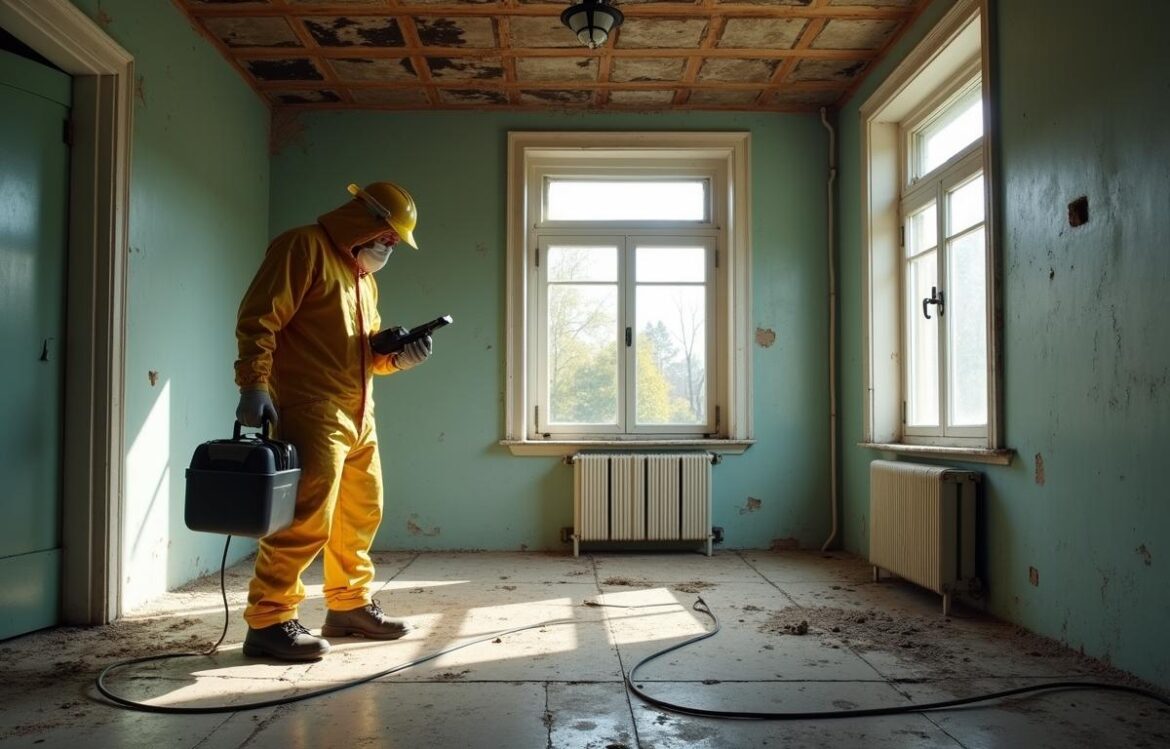
Identify asbestos risks can be a vital step in ensuring your household remains protected from potential health hazards. For many years, asbestos was a go-to material in construction, particularly in older structures built before the 1980s. If it stays intact, it may seem harmless. But when asbestos fibers become airborne, there’s a heightened risk of adverse health effects. Understanding where asbestos might lurk and how to handle it can make a significant difference in keeping you and your loved ones safe.
Contents
Common Spots Where Asbestos May Hide
Older homes often contain asbestos in familiar places. Insulation materials and floor tiles used decades ago are frequent culprits, though asbestos-containing materials might also appear around roofs and walls. These parts, when left undisturbed, may pose little danger. Still, any renovation or structural disturbance can increase asbestos exposure.
It helps to hire qualified professionals trained in asbestos inspections when you suspect trouble. They can discover if hidden materials in your walls or flooring have deteriorated. They may even offer guidance on asbestos testing, which is crucial if you notice signs of damage or wear in suspected products. If the tests come back positive, the next steps might involve asbestos abatement or asbestos removal.
Checking Insulation And Other Hidden Areas
Insulation in attics and around pipes is worth a closer look. Damaged insulation can release fibers into the air. Some older adhesives and decorative coatings might also contain asbestos, so stay alert during any upgrade or remodel project. If you plan to open up a wall or tear down old ceiling tiles, scheduling professional asbestos testing should be first on your list to reduce environmental asbestos risks.
The Role Of Regulations
Countless guidelines focus on asbestos regulations for good reason. Governments recognize the health dangers involved. Renovation permits often require an asbestos risk assessment if a building is older than a certain age. These policies ensure building owners address asbestos safety measures promptly, helping reduce dangers for anyone who lives or works inside.
Potential Health Complications Linked to Asbestos Exposure
Asbestos exposure can lead to serious health consequences. Asbestos-related diseases, including mesothelioma, typically develop after repeated inhalation of microscopic fibers that irritate and damage the lungs. The latency period can be lengthy. Individuals might remain symptom-free for decades, only to face life-threatening conditions later.
Though asbestos was widely used for its fire-resistant properties, the health toll has become undeniable. Risks of asbestos must be taken seriously in every setting, whether you’re a homeowner, landlord, or contractor. When in doubt, contact professionals who specialize in asbestos hazard assessment to minimize any unwanted surprises.
Long-Term Lung Damage
Prolonged exposure to asbestos fibers can contribute to chronic breathing problems. Scar tissue can form, making it harder for air to pass through the lungs. Professional asbestos awareness training emphasizes how early detection of breathing issues could help slow down these complications. Doctors may suggest periodic screenings if you’ve lived in an environment where asbestos was discovered.
Occupational Risks
Some individuals face higher occupational asbestos exposure due to the nature of their jobs. Workers involved in construction, shipbuilding, and firefighting may regularly encounter asbestos. Employers should have an asbestos management plan in place, along with regular asbestos inspection procedures to safeguard workers’ health. Proper protective gear and regular health monitoring might reduce mesothelioma risks and other occupational hazards.
Effective Ways To Mitigate Asbestos Dangers
Once a test confirms asbestos in buildings, there are specific steps you can take to ensure better asbestos safety. These methods will vary depending on the level of contamination and the physical condition of the materials. A small amount of asbestos that’s still sealed up might be left alone under a watchful eye, while a deteriorating ceiling might warrant urgent asbestos remediation.
It’s essential not to disturb asbestos materials if you lack the experience or proper equipment. Although some homeowners might feel tempted to handle minor issues themselves, the health dangers are real. Professional asbestos removal teams have the protective gear, sealing devices, and detailed work plans to keep fibers contained. Any slip-up can release fibers into your living space, so leaving this to certified professionals often remains the safest bet.
Encapsulation And Enclosure
Encapsulation involves applying a sealant that bonds to asbestos-containing materials, preventing fibers from escaping. This approach doesn’t remove asbestos entirely but does keep it intact, minimizing risk. Enclosure is another tactic where the asbestos area gets physically isolated, using barriers like paneling to seal off the contaminated zone. Both methods can be cheaper than complete removal. Still, regular asbestos monitoring is essential to ensure conditions remain stable over the long haul.
Professional Removal And Disposal
Asbestos abatement specialists follow strict procedures regulated by local authorities. They wear specialized suits and masks to avoid inhaling asbestos fibers during the process. They also seal off the home area to keep particulate matter from dispersing. After asbestos removal, waste gets placed in labeled, sealed containers that comply with disposal guidelines. This attention to detail ensures everyone stays safer and prevents accidental exposure.
Practical Steps To Keep Your Home Safe
Maintaining the safety of household members should always be a priority. If you suspect your house has hidden threats, prompt action will make a huge difference. Even routine checkups from certified inspectors can boost peace of mind.
Start by scheduling periodic asbestos inspection. Teams can assess whether existing asbestos-containing materials remain intact or have started breaking down. Through asbestos risk assessment, they’ll detect areas that pose potential danger. If concerns surface, appropriate asbestos testing can follow. Attending to hazards early may save on bigger costs and more complex procedures later.
While attending to asbestos concerns, it’s also wise to consider other potential hazards in older building materials. For example, deteriorating paint may contain lead or other harmful substances. Therefore, arranging lead paint testing often helps determine whether additional precautions are necessary, enabling a more comprehensive and safer maintenance plan. Ultimately, attending to hazards early may save on higher costs and more complex procedures later.
Follow A Management Plan
A solid asbestos management plan includes scheduling maintenance checks, documenting the location of asbestos in buildings, and limiting access to affected areas. If you plan on any renovations, inform contractors about known asbestos hazards so they can follow recommended asbestos guidelines. Keeping track of any changes to walls, floors, or ceilings helps you act sooner if something appears off.
Adhere To Local Rules
Local authorities often have specific asbestos regulations for renovating older properties. Some municipalities may demand documentation proving inspection before granting a permit. This framework ensures asbestos abatement follows proper safety measures. You’ll also want to stay updated about disposal rules, as dumping asbestos-laden materials in the regular trash is generally illegal. Adhering to these requirements keeps you in line with the law and helps protect local communities.
Staying Proactive With Regular Inspections
Long after completing asbestos removal or encapsulation, regular checks can help prevent surprises. Contractors might advise yearly or biannual reviews, depending on your home’s age and construction. Even small cracks or water leaks could disrupt sealed areas. Early detection curbs larger problems that would otherwise become more expensive to resolve.
Remain aware of changes in your home’s structure and appearance. Watch for peeled paint, crumbling insulation, or unusual debris on surfaces. Whenever something seems amiss, calling in a pro for asbestos testing is a wise precaution. Not only can this safeguard your family’s health, but it also preserves the property’s value if you ever intend to sell.
Emphasizing Awareness And Education
Take advantage of any asbestos awareness training opportunities available in your community. Basic knowledge helps you recognize suspicious signs and alerts you to harmful practices like sanding or drilling into walls without protective measures. It also provides up-to-date information about asbestos hazards and where they commonly appear.
If you share your home with tenants, let them know about the presence of asbestos if you have confirmed it. Highlight the importance of not disturbing suspected materials. Ensure they contact you instantly if they see damaged walls or ceilings. Good communication reduces the chance of accidental contamination and lengthy cleanups.
When To Seek Professional Help
While basic vigilance is crucial, certain tasks call for expert assistance. This includes anything that might release loose asbestos fibers into the air, such as demolishing walls or removing older floor tiles. Engaging a certified asbestos inspection company lets you proceed with confidence. They’ll collect samples properly and use laboratory equipment to confirm potential contamination.
Qualified professionals also help you comply with asbestos regulations. Breaching these rules can result in hefty fines. Plus, an unauthorized approach might put you or workers at risk of asbestos-related diseases. When a project surpasses your comfort or skill level, it’s safer to have a professional perform asbestos testing and, if needed, asbestos remediation.
Coordinating With The Right Specialists
You might come across professionals labeled as asbestos inspectors, abatement contractors, or environmental hygienists. They have varied roles but often work in tandem to create safe living environments. Some focus on pinpointing asbestos hazards, while others handle removal or sealing. If different specialists are involved, keep track of what each person is doing to ensure a coordinated approach.
Ensuring Proper Disposal
After asbestos removal, reputable contractors will transport waste to certified sites that handle hazardous materials. This step is not just about compliance. It also prevents asbestos hazards from migrating elsewhere in the community. If your cities or towns have unique protocols, follow them diligently by using official channels for asbestos disposal. Doing otherwise can harm the environment and endanger unsuspecting individuals.
Maintaining a home free from lurking threats supports a healthier life for everyone. By paying close attention to places where asbestos might hide, taking proper precautions, and seeking professional guidance when needed, you significantly reduce the risks of asbestos. Each effort you make can contribute to better indoor air quality and more peace of mind.



